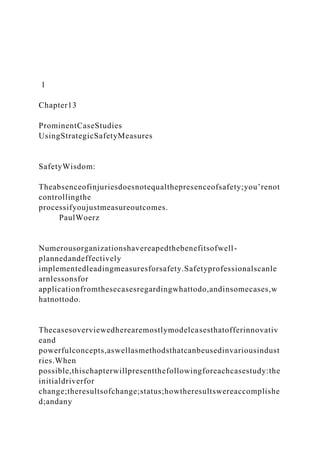
1Chapter13ProminentCaseStudiesUsingStrate.docx
- 7. injuriesdoesnotindicatethepresenceofsafety.” Paulalsoasksquestionsaboutsafetyperformance.Henotes,typically ,when youaskaboutsafetyperformance,youwillbegivenoutcomenumbers suchasinjury rates. ForExample: 4 Whattomeasure?Yourrisks.Whichrisks?Themostsevererisks. Example:100machinesinthemachineshopand55%ofthemareproper lyguarded. Pauldrillsdownandasksthefollowingquestions: 1. Isthererisk? 2. Ifcomplianceincreasesto75%-Istherelessriskthanbefore? 3. Williteventuallyleadtoaninjury? 4. Isthisacceptabletoyou? 5. Whatabout95%compliance?99%?Istherestillarisk?Isthisacceptab leto you? Paulexpandedfromthissimpleexampletotargetthecontextofthefata litiesthatwere occurringathisorganization.Thecontextforfatalitiesincludedthefo llowing“Big Four.”
- 8. TheBigFourforSafetyinPaul’sDivision Therewerefourcategorieswherethefatalitiesandseriousinjurieswer e occurringinPaul’sdivision.Theseinvolvedafailuretofollowtheproc eduresfor lockout/tagout,fallprotection,mobileequipment,andconfinedspac eentry.The followingaresomeoftheelementsthatweremeasuredwiththeexpect ationthatthere wouldbe100%compliance. Lockout/Tagout 1. The%ofequipmentspecificisolationprocedureswritten 2. The%ofemployeesfoundfollowingLO/TOprocedures 3. The%oftagsandlocksproperlyplacedbyeachemployeeonthejob 4. Wasverificationtoassurede- energizationdonebyeachpersonwhoapplied locksandtags? FallProtection 1. The%ofemployeesatelevatedlevelsthatareproperlywearingfall protectionharnessesatrequiredheights 2. The%ofroofaccesspermitscompletedasrequired MobileEquipment 1.The%ofemployeeswearingseatbeltsasrequired 2.The%ofpre-useinspectionsdocumentedpriortouseofthevehicle 3.Areanyvehicle/pedestrianinterfaceissuespresent? 4.Areanyloadsbeingliftedorraisedoveremployees?
- 9. ConfinedSpaceEntry 1. The%ofmonthlycalibrationscompletedanddocumented 2. The%ofpre-usebumptestsconductedanddocumented 3. Werespacespecificentryproceduresreviewedandfollowedpriortoe ntry? 5 4. The%ofconfinedspacepermitsfullycompleted 5. Areallentrantslistedonthepermit? 6. Arespacesequippedwithsignageregardingpermitrequired? Compliance–DoingtheBasicsRightWhenConsequencesareGreat Pauldeterminedthatinordertopreventmajorincidentsandfatalities,t hesegmentof hisorganizationMUSTexpectandachieve100%complianceinthesef ourareas. Becausethepotentialconsequencesweresogreat,ifanemployeewasf oundtobe violatingoneoftheBigFourSafetyprocedurestheyweredisciplineda ndsometimes discharged.Insomeinstances,theemployee’simmediatesupervisor wasalso disciplinedordischarged.Thisprovedthecompanywasseriousabout thesafety process,anddeviationfromtheirstandardswouldnotbetolerated.De viationfrom
- 20. 10 Ofparticularinteresttosafetyprofessionalswhoaremakingdecisions aboutselecting leadingindicatorsformeasurement,Toellnerdevelopedthefollowin gfivekeyquestions foridentifyingandselectingleadingindicators: 1.Whatarethekeyprocesseslinkedtoyoursite’ssafetysuccess? 2.Aretheseprocessesmeasurable? 3.Ifyoudomoreleadingmeasures(orimprovethequalityofthem)will safety improve? 4.Ifyoudon’tstewardthem,istheratelikelytodrop? 5.Iftheratedropswillperformancedecline? TheGulfPlatformProject ThiscaseinvolvedtheconstructionofanoilplatformintheGulfofMex ico.Keeping workerssafewasarealchallengebecausetherewereanumberofissues forthe project: • Theworkforcewasrelativelyinexperienced; • Therewere1200workersinasmallareaandatmultipleheights; • Thecostandschedulewerecompetingforprioritywithsafety;and. • Safetywasanewvalueformanyonthesite.
- 24. • DemonstratingCare, • Communication, • Training,and • Resources. 12 Toprevent“negativeenergy,”organizationsshouldavoidinitiativest hatproducefearof failureanddelegationofleadership. Efficiencyimpliesthebetteryoudoit,thegreaterthechanceitwillbee mbracedbythe team.Itincludesthefollowingaspects: • AlignmentonExpectations, • ProcessesfitforPurpose, • RecognitionofRisk, • ControlsEffective(yetnotoverbearing), and • ApplicationofLessonsLearned. InefficiencyincludeselementssuchasMixed SignalsandExceedingOrganizationalCapacity. LessonsLearnedfromExecutingLeadingSafetyMeasuresatExxon Mobil ThefollowinglessonslearnedareadaptedfromJackToellner’spaper publishedbythe SocietyofPetroleumEngineerson“LessonsLearnedinExecutingLea dingSafety Indicators.”
- 26. initiatives that produce fear of failure and delegation of leadership 13 Toellnerrecommendsthatteamsdon’tchoosetomeasureaprocesstha tisalready beingsuccessfullyexecuted,andendupessentiallyspendingenergyv alidating somethingthatisalreadysuccessful.Rather,“Leadingindicatorsaren otaboutshowing justourbestside(e.g.,thebeautypageant),theyareaboutrecognizing ourless flatteringsidewhereweneedadditionalwork,andthengoingandpouri ngenergyinto improvingthoseareasofweakness.” Lesson#3:Youmaythinkyoucan,butyoureallycan’tmeasureeveryth ing.ToBe effective,onemustprioritize. Acommonfailureoccurswhenteamstrytotakeontoogreatachallenge .Theremay beabeliefthatifseveralleadingindicatorsaregood,thenmoreisevenb etter! Organizationalresourcesandcapacityarenotunlimited,andit’simpo rtanttorecognize thisfactbylimitingthenumberofleadingindicatorsbeingstewardedb yan organization.Anunintendedconsequenceofmaking“everythingimp ortant”isthat essentially“nothingisimportant.”Wecan’tfocusoneverythingatonc e.
- 31. r,theperson whoseideasinfluencedtheevolutionofbehavioralsafetyarefromSaf etyThought LeaderDominicCooper.Cooperhasdocumentedcasestudies,lesson slearned,and conceptsforsuccessfulimplementationandexecutionofbehaviorals afetyinhisbook, BehavioralSafety:AFrameworkforSuccess. ThefoundationfortheadvancedapproachtoBBSwasthattheprincipl esofthis bookwouldbeappliedtotheapproach.Thefollowingprincipleswerea ppliedforBBS leadingmeasures: • Therewouldbeamixofleadingandlaggingindicators; • Therewouldbeamixoftypeoneandtypetwomeasures; • Therewouldbeamixofmeasuresforemployeesandforleadership;and • Primarymeasureswouldbelimitedinnumberfromthreetofive measures. Theconceptoftypeoneandtypetwomeasureswereinfluencedbythew orkof TerryMcSween.Basically,typeonemeasuresaremeasuresthatidenti fyandaddress practicesthatcreatethemostexposuretoinjury,i.e.,theworkisbeingd onesafely.An exampleofatypeonemeasureinBBSis“percentsafe.”Onemightsayt hattypeone measurescouldbe“consideredaconditionofemployment,”especiall yforindustries wherefailuretoworksafelycouldresultindisablinginjuriesorfataliti
- 33. fely. Withtheseprinciplesinmind,thefollowingfivemeasuresfortheadva ncedapproach weredeveloped.Thefirstandfifthmeasuresareleadershipmeasures, whilethe second,thirdandfourthmeasuresareprimarilyemployeemeasures: Measure1.SafetyLeadershipScores Thismeasureisself-managedandself- designed.Althoughitisa“soft”measure,itcan haveagreatimpactonperformance.Withthesafetyleadershipscores, thereare separatelydesignedpinpoints(orspecificallydefinedbehaviors)sele ctedby managementandself-managed.Theself- reportcriterioncoversaweeks’timeframe andincludesagreenlightifthebehaviorsareconducteddaily,suchasf ourorfivetimes inaweek;ayellowlightfortheselectedbehaviorscompletedtwoorthr eetimesina week,andaredlightifthebehaviorsaredonerarelyornever. Behaviorsareselectedfromalistofwaystosupportthesafetyprocessa ndinclude itemssuchas: • Performingsafetywalkaboutstodiscusssafety; • Ensuringthecloseoutofsafety-relatedcorrectiveactions; • Conductingsafetycoaching; • Promotingsafetycoaching; • Attendingsafetyrelatedtrainingwiththeteam; • Recognizingemployeesforworkingsafely;
- 47. impactingsafetyperformance; • Commonissueswithrewardsandincentives; • Guidelinesformakingrewardandrecognitionprogramseffective; • Strategiesformaximizingindividualandteamrecognition;and • Developingsafetymetricsthatmotivateandreinforceperformance. Introduction Anelementofcontroversysurroundsthetopicofrewardsforsafety,es pecially regardingincentiveprograms.Psychologistswhohavebecomeinvol vedintheareaof safetyvarygreatlyintheiropinionsabouttheeffectivenessofsafetyin centiveprograms andsafetyrewardsingeneral. AlfieKohnwrotePunishedbyRewards:TheTroublewithGoldStars,I ncentive Plans,A’s,Praise,andOtherBribesandinsiststhatmotivationandinc entivescomefrom intrinsicsources,andthatexternalrewardsdefeatthepurposeofmotiv ation.The bookreviewstates:
- 66. conceivedthathygienefactorsincludedissatisfactionandnodissatisf actionareonone continuum,andnosatisfactiontosatisfactionareoppositesontheothe rmotivation continuum. InHerzberg’stheory,hygienefactorsarethosethingsthatkeeppeople from beingdissatisfiedandincludethingssuchas: • Workingconditions, • Levelandqualityofsupervision, • Companypolicyandadministration, • Interpersonalrelations, • Jobsecurity,and • Salary. AkeypointHerzbergmadeabouthygienefactorsistheydonotmotivat e.Whenthey areinplace,theykeeppeoplefrombeingdissatisfied.
- 67. Thesecondcontinuumisbasedonthingsthatmotivatepeople.Thescal egoes fromnosatisfactiontosatisfaction.Thefollowingfactorstendtosatis fyandmotivate people: • Natureofthework, • Senseofachievement, • Recognition, • Responsibility,and • Personalgrowthandadvancement. It’simportanttounderstandthatbothhygienefactorsandmotivatorsa renecessaryfor peopletobefullymotivated.Forexample,ifhygienefactorsarelackin ginsome manner,thenmotivatorsbythemselvesarenotenoughtobringoutmoti vation.The hygienefactorsarefoundational,andintrinsicmotivatorsmustbepre sent. Essentiallythetwo-
- 73. aremeasuredonaregularbasis.Theseengagementopportunitiescoul dincludeawide varietyofactivitiessupportingthesafetyefforts.Examplesincludepa rticipatingin: • safetymeetings, • safetytraining, • safetyinspections, • safetyaudits, • IHinspections, • Leadingstretchingsessions,and,butnotlimitedto, • Leadingbrownbagsafetymeetings 2.Celebrateevensmallachievementsthatarerelatedtothemeasurabl ebehaviorsand actionstakentoimprovesafetyperformance. 3.Asappropriate,recognizeteamsandindividualsfortheirsafetyeffo rts,inmuchthe samemannertheymightberecognizedforproductionexcellenceorco stsavingsideas. Theexpectedbenefitsfromtakingthesesimplestepsinclude:
- 85. Reports. Resultsofthecasestudyincluded: • Thenumberofreportsincreased. • Thequalityofmostofthereportsincreased. • Anumberofeasilycorrected,yetsignificantrisks,weremitigated. Regardingtherisksthatwereidentifiedandmitigated,acoupleofsigni ficantexamples included: • Itwasdiscoveredthatfaultyhot- stickswerestillbeingcarriedonsomeservice trucks,andthiscreatedapotentiallyseverehazardthatcouldhaveresu ltedin electrocutionsandfatalities.Controlsweresetinplacetoensuredefec tivetools wereremovedfromservice. •